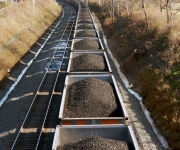Cross-posted from Sightline Daily.
Here are three pictures that help explain why American railways seem to be supporting coal export proposals in the Northwest. It’s because railways are very closely connected to the coal industry. Consider:
Coal so dwarfs every other rail-hauled commodity that it is almost as important as all the other commodities combined. (Note: This picture excludes “intermodal” freight.)
But while coal is a huge component of rail freight, it declined noticeably in 2009 and 2010:
Presumably, a good deal of the recent decline is related to a lousy economy and the attendant reduction in demand for electrical power and industrial uses of coal. Yet the recently depressed coal rail volumes are not entirely driven by the economic downtown. In fact, coal fired-power is on a long-term downward trajectory:
Going forward, that downward trend is likely to continue, and perhaps accelerate. Regulators are tightening pollution standards; other power sources like natural gas and renewable energy are becoming increasingly competitive in the marketplace; and communities across the country are averse to coal-fired power for its deleterious health effects.
Power plants are not the only customers that railways service with coal shipments, but they easily constitute the lion’s share. So given the ongoing decline (and dismal future prospects) for domestic coal use, it’s no wonder that railway companies support big new coal export facilities. As Americans are increasingly uninterested in buying coal, railways will want to find consumers — no matter how far afield they may be — who will pay coal to be moved by rail, whether it’s to a power plant or an export terminal.
Notes: I created the first chart using data from the table on page 8 of the American Association of Railroad’s “Rail Time Indicators” report for Jan. 2011. (The AAR data does not combine commodity carload data with figures for intermodal freight, which amounted to 11.3 million trailers and containers in 2010.) The second chart comes directly from page 13 of that same report. The third chart is taken from the most recent rail indicators report [PDF], which was published in Dec. 2011.




